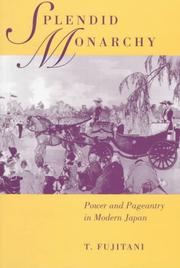| Listing 1 - 5 of 5 |
Sort by
|

ISBN: 0520202376 0520213718 Year: 1996 Publisher: Berkeley (Calif.) : University of California press,
Abstract | Keywords | Export | Availability | Bookmark
 Loading...
Loading...Choose an application
- Reference Manager
- EndNote
- RefWorks (Direct export to RefWorks)
Emperor worship --- Emperors --- Monarchy --- Japan --- History --- Kings and rulers.

ISBN: 0585104387 0520920988 9780520920989 9780585104386 9780520202375 0520202376 0520202376 0520213718 9780520213715 Year: 1996 Publisher: Berkeley University of California Press
Abstract | Keywords | Export | Availability | Bookmark
 Loading...
Loading...Choose an application
- Reference Manager
- EndNote
- RefWorks (Direct export to RefWorks)
Using ceremonials such as imperial weddings and funerals as models, T. Fujitani illustrates what visual symbols and rituals reveal about monarchy, nationalism, city planning, discipline, gender, memory, and modernity. Focusing on the Meiji Period (1868-1912), Fujitani brings recent methods of cultural history to a study of modern Japanese nationalism for the first time.
Emperor worship --- Emperors --- Monarchy --- HISTORY / Asia / General. --- Kingdom (Monarchy) --- Executive power --- Political science --- Royalists --- Japanese emperors --- Emperor worship, Japanese --- Japan. --- J4624 --- Japan: Politics and law -- state -- emperor --- E-books --- Japan --- History --- Kings and rulers. --- ceremonials. --- city planning. --- discipline. --- gender. --- imperial institution. --- imperial weddings and funerals. --- meiji period. --- memory. --- methods of cultural history. --- modernity. --- monarchy in japans modernity. --- monarchy. --- nationalism. --- study of modern japanese nationalism. --- tokyo as temporary court. --- visual symbols and rituals. --- volume six.
Book
ISBN: 1280105267 9786613520593 0520950364 Year: 2011 Publisher: Berkeley : University of California Press,
Abstract | Keywords | Export | Availability | Bookmark
 Loading...
Loading...Choose an application
- Reference Manager
- EndNote
- RefWorks (Direct export to RefWorks)
"Race for Empire offers a profound and challenging reinterpretation of nationalism, racism, and wartime mobilization during the Asia-Pacific war. In parallel case studies--of Japanese Americans mobilized to serve in the United States Army and of Koreans recruited or drafted into the Japanese military--T. Fujitani examines the U.S. and Japanese empires as they struggled to manage racialized populations while waging total war. Fujitani probes governmental policies and analyzes representations of these soldiers--on film, in literature, and in archival documents--to reveal how characteristics of racism, nationalism, capitalism, gender politics, and the family changed on both sides. He demonstrates that the United States and Japan became increasingly alike over the course of the war, perhaps most tellingly in their common attempts to disavow racism even as they reproduced it in new ways and forms"--
World War, 1939-1945 --- Nationalism --- Racism --- Imperialism --- Participation, Japanese American. --- Participation, Korean. --- Social aspects --- History --- allied forces. --- america and asia. --- america and japan. --- asia and war. --- asia pacific modern. --- asia pacific war. --- asian american studies. --- asian empire. --- asian history. --- asian studies. --- cultural anthropology. --- cultural studies. --- eastern asia studies. --- enemy combatants. --- history. --- japanese americans. --- japanese colonialism. --- japanese historians. --- japanese history. --- japanese imperialism. --- korean historians. --- korean history. --- korean war history. --- military drama. --- us historians. --- us history. --- war and battles. --- war and racism. --- war in asia. --- wwii history.
Book
ISBN: 9780520950368 9780520262232 9780520280212 Year: 2011 Publisher: Berkeley University of California Press
Abstract | Keywords | Export | Availability | Bookmark
 Loading...
Loading...Choose an application
- Reference Manager
- EndNote
- RefWorks (Direct export to RefWorks)
Race for Empire offers a profound and challenging reinterpretation of nationalism, racism, and wartime mobilization during the Asia-Pacific war. In parallel case studies--of Japanese Americans mobilized to serve in the United States Army and of Koreans recruited or drafted into the Japanese military--T. Fujitani examines the U.S. and Japanese empires as they struggled to manage racialized populations while waging total war. Fujitani probes governmental policies and analyzes representations of these soldiers--on film, in literature, and in archival documents--to reveal how characteristics of racism, nationalism, capitalism, gender politics, and the family changed on both sides. He demonstrates that the United States and Japan became increasingly alike over the course of the war, perhaps most tellingly in their common attempts to disavow racism even as they reproduced it in new ways and forms.
Imperialism --- Racism --- Nationalism --- World War, 1939-1945 --- History --- Social aspects --- Participation, Japanese American
Book
Year: 2000
Abstract | Keywords | Export | Availability | Bookmark
 Loading...
Loading...Choose an application
- Reference Manager
- EndNote
- RefWorks (Direct export to RefWorks)
| Listing 1 - 5 of 5 |
Sort by
|

 Search
Search Feedback
Feedback About UniCat
About UniCat  Help
Help News
News